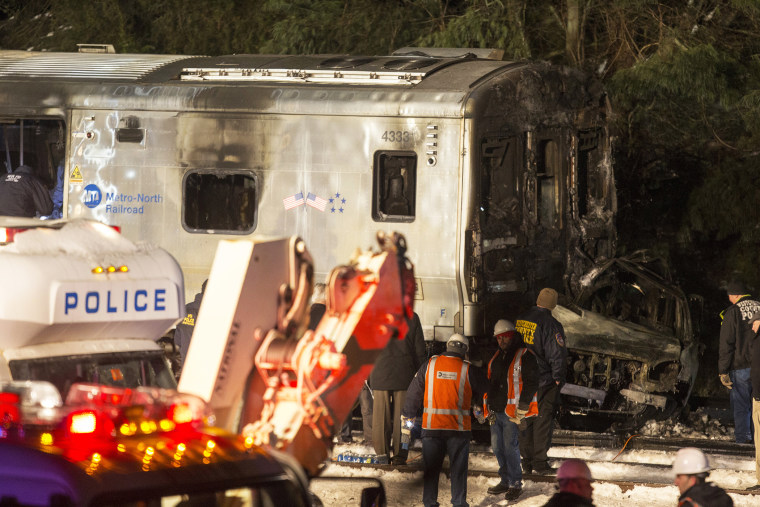Updated at 7:45 p.m. ET to reflect the revised death toll.
Six people were killed after a crowded commuter train slammed into a sport utility vehicle on the tracks north of New York City on Tuesday.
The crash caused the SUV to explode in a fireball that set the front of the train ablaze, officials said. About 15 people were hurt, Gov. Andrew Cuomo said.
It was the deadliest accident in the history of the Metro-North system, which carries about 285,000 passengers a day.
"You have seven people who started out today to go about their business, and aren't going to be making it home tonight," Cuomo told reporters Tuesday night near the scene of the 6:30 p.m. crash in Valhalla, about 30 miles north of Grand Central Terminal in Manhattan. "It's a painful reminder to all of us how precious life is, and sometimes how random it can be."
Cuomo gave the revised death toll of six in an interview with NY1, a local cable news channel. Authorities had said on Tuesday that seven people were killed. There was no immediate explanation for the discrepancy.
Five of the dead were on the northbound train, Cuomo said. The driver of the Jeep was also killed. That train typically carries about 650 people when it leaves Grand Central bound for northern suburbs, officials said.
The Metropolitan Transportation Authority said the Jeep was stopped on the tracks when a railroad crossing gate came down on top of it. The driver got out, checked the rear of the vehicle, and then she got back in and drove forward and was struck by the train, the agency said.
Cuomo called the scene of devastation "a truly ugly and brutal sight." The Jeep was pushed 400 feet down the track, and the third rail was torn up and sent through the vehicle and into the first car.
"When you look at the damage done, and the damage by the fire, it's actually amazing that not more people were hurt on that train," Cuomo said.
The National Transportation Safety Board dispatched a team of investigators to the crash site. MTA Chairman Tom Prendergast said the train's event recorder should help to piece together the circumstances surrounding the crash.
Deborah Hersman, the former chair of the National Transportation Safety Board, said that trains such as the ones that crashed generally have devices that record speed, throttle position, braking patterns and bells and whistles.
Investigators will also scour any video footage recorded on the train or at the scene, she said.
"Obviously there's a lot of people in the vicinity, so we might actually have witnesses," she told TODAY.
Passengers described a jolt, and then an announcement that the train had struck a vehicle. Some passengers had to break the glass on doors to get out; others used ladders to descend from the stopped train.
Jamie Wallace was sitting in the second car from the front when the train slammed into the Jeep. There were panicked calls for a fire extinguisher farther up the train, he said, but the doors to the first car were jammed shut. They tried to break the glass to reach the first car.
"A number of us were smelling fumes from the car, fuel, and we said, 'you know, we need to get out.' The fire was starting to spread back toward the second car," Wallace told NBC New York.
Family members gathered at Westchester Medical Center Tuesday to await word on their loved ones. One frightened woman told NBC News she was too distraught to talk, saying, "My husband might be dead."
Neil Rader normally sits near the front of the train on his commute to his home in Katonah, but he was running late and ended up in the middle of the train, closer to the rear. "I'm very fortunate," he said.
Stacey Eisner, an NBC News Group employee, was a passenger in one of the rear cars of the train, and said she felt the train "jerk." There was no loss of power or heat, but it felt like the train had turned off, she told NBC News. Eisner said the conductor walked through the train to explain what had happened. Passengers were calm at first, but tension began to build when they learned the train had hit a car, she said.
About 10 to 15 minutes after the train "jerk," Eisner's train car was evacuated, with ladders used to get people out.
Metro-North has had several recent accidents, including a Dec. 1, 2013, derailment that killed four passengers and injured 61.
In that accident, investigators found that engineer William Rockefeller fell asleep before the train roared into a 30 mph curve at a speed of 82 mph. The National Transportation Safety Board said an undiagnosed condition of sleep apnea contributed to the crash.
Four other accidents in New York and Connecticut in 2013 and 2014 were blamed by the NTSB on a lack of track maintenance and poor communication.
U.S. Sen. Chuck Schumer said the MTA has pledged a full and thorough investigation.
"Our hearts go out to those lost, we pray for those injured and our hats are tipped to the brave first responders who came to the scene of this tragic crash so quickly," Schumer said in a statement. "At this early stage, it is premature to point any fingers of blame, but there are many important questions that must be answered in the coming days."
NBC News' Niven McCall-Mazza, Tracy Jarrett and John Brecher contributed to this report.
This story originally appeared at NBCNews.com
